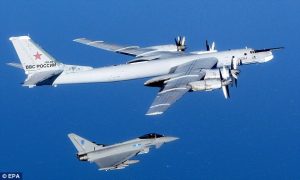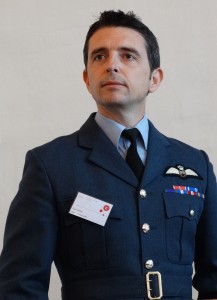2016-11-19 By Robbin Laird
I first visited RAF Lossiemouth in April 2016.
In a return visit in June, I was able to get updates on the RAF preparation for P-8s, an update on the Typhoon and operations in the Middle East, a discussion of the ground support system for Typhoon, a look at the Tornado weapons training approach and leveraging the approach moving forward into the Tyhpoon/F-35 era, and a look at the nature of the Quick Reaction Force at QRA North.
We will publish materials on these various aspects of the visit in coming weeks.
But during the visit, I had a chance to continue my earlier conversation with the RAF base commander and to get his perspectives, notably after his return from Estonia where he was able to look at the performance of RAF Lossiemouth Typhoons on deployment to the Baltic Air Policing effort.
Question: You recently returned from Estonia.
How is the effort going?
Group Captain Godfrey: It is very similar in mission to QRA in the UK; as you know we have QRA NORTH which is here at Lossie, and QRA SOUTH at RAF Coningsby.
The facilities in Estonia are of the same level and quality we have here in the UK.

You will have seen in the media, that our aircraft are busy intercepting Russian aircraft, including those launched from Kaliningrad although I do think the dynamic has changed slightly since we’ve been operating in the same AOR as the Russians in Syria.
We know more about each other given the deconfliction that we’re going through in Syria and Iraq AORs.
Question: Are there differences between QRA in the UK and in the Baltics?
Group Captain Godfrey: The template is the same but the mission is slightly different.
From the UK, we are largely dealing with Russian Long-Range Aviation with crews that are ‘used’ to being intercepted by European Fighters
In the Baltics, we are often intercepting Russian fighters, and there the adherence to a common template is a work in progress. For several Russian pilots, this may be the first time they seen or dealt with a Typhoon and they are learning the process of how to work safely in such situations.
We are dealing with a different generation of pilots.
Question: How is Typhoon doing in performing the mission?
Group Captain Godfrey: We are building on the experience of the other Typhoon nations, earlier German and Spanish deployments as well as our own, in creating a solid understanding of the infrastructure support.
It is great to have an aircraft able to deal with any of our likely eventualities in performing the mission.
Question: The P-8 is coming to the RAF and during a recent visit to Jax Navy we were able to see some of the capabilities which you mentioned last time, certainly in terms of its ability to do more than simply do classic maritime patrol.
What is your sense of its potential impact?
Group Captain Godfrey: If we open our intellectual aperture, and do not stymie it by doctrine, the P-8 becomes a key part of overall evolving combat force, and not simply as you say a classic maritime patrol aircraft, doing a specialized mission.
It’s all about on board sensor fusion.

With F-35 and P-8 out in the battlespace, we have the potential to shape collective sensor fusion to give absolutely everybody, either airborne, on the sea, on the land the same situation awareness to allow for enhanced timely decision-making.
And that will affect how we operate Typhoon here as well, as we work greater integration across the combat fleet.
P-8 can be the wingman for F-35; F-35 can be the wingman for P-8; and Typhoon can operate as the weapons force multiplier of the evolving force, and a key force protection element as well.
It will be important for our air doctrine to be reworked as our force finds ways to cross-transform rather than trying to fit these multi-mission and multi-tasking assets into classic doctrinal boxes such as strike, mobility, lift, etc.
We are at the beginning of a long road.
I am not sure of the direction in which the road is going which is probably a good thing for if we set the direction to narrowly we will limit the innovation, which is possible.
For the new Special Report which includes all of the Second Line of Defense interviews from RAF Lossiemouth, see the following:
https://sldinfo.com/visiting-raf-lossiemouth-the-raf-shapes-a-way-ahead-2/


